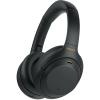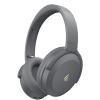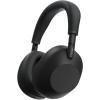Noise cancelling is one of the most talked-about features in modern headphones and earbuds. If you’ve been looking at buying a new pair, you’ve likely come across the terms active noise cancelling (ANC) and passive noise cancelling, but what do they actually mean?
Here’s a breakdown of how each one works, where they’re most useful, and how to know which type might suit you best.
What Is Passive Noise Cancelling?
Passive noise cancelling is the most basic type of noise reduction, and it doesn’t involve any electronics. It works simply by physically blocking sound from reaching your ears.
This is achieved through the design and materials of the headphones. Over-ear headphones with thick, cushioned ear cups can block out a lot of surrounding noise. In-ear earbuds can also create a good seal inside your ear canal, which helps reduce external sound.
You don’t need batteries or any power for passive noise cancelling to work, it’s all about the shape, fit, and padding.
Best for
- Reducing general background noise like people talking nearby
- Office or home use
- Travelling light, especially with in-ear headphones
Limitations
- Doesn’t block out consistent, low-frequency sounds like engine rumble or air conditioning
- Depends heavily on fit and materials
What Is Active Noise Cancelling?
Active noise cancelling takes things further by using microphones and built-in electronics to block sound in real time.
Here’s how it works:
- Small microphones on the outside of the headphones pick up ambient sounds.
- The headphones then produce a sound wave that is the exact opposite of the noise coming in.
- These two sound waves cancel each other out before the noise reaches your ears.
The result is that steady background sounds, like the hum of an aeroplane, bus engine, or air conditioning, are dramatically reduced. Some headphones also include microphones inside the ear cup to fine-tune the effect even more precisely.
Best for
- Flying or commuting
- Noisy environments like offices or cafes
- Blocking low-frequency, constant sounds
Limitations
- Requires power, so it drains battery faster
- Some models can introduce slight pressure or a faint hiss
- Not as effective at cancelling sharp or sudden sounds like voices or keyboard typing


Key Differences at a Glance
| Feature | Passive Cancelling | Active Cancelling |
|---|---|---|
| How it works | Physically blocks sound | Cancels sound using microphones and waveforms |
| Power Required | No | Yes |
| Blocks steady sounds | Some | Very effective |
| Blocks voices or sharp sounds | Limited | Can reduce but not eliminate |
| Found in | Most headphones and earbuds | Mid to high-end models |
Do All Noise Cancelling Headphones Use Both?
Many premium headphones use a combination of both. They are designed to fit well to passively reduce noise, while also using active noise cancelling to cut out more consistent sounds.
This combination gives better results overall, especially in noisy environments. However, not all models include ANC, and some rely purely on passive design, especially in lower price ranges or lightweight earbuds.
Is One Better Than the Other?
Neither one is better across the board, it depends on where and how you use your headphones.
If you just want something simple to cut out background chatter or don’t want to worry about battery life, passive noise cancelling may be all you need.
If you regularly travel, commute, or work in noisy environments, active noise cancelling can make a noticeable difference in how much sound is blocked and how clearly you can hear your audio.


What About Transparency Modes?
Some headphones with ANC also include a transparency or ambient mode. This lets outside sound in on purpose when needed, for example, when you want to hear announcements at the airport or have a quick conversation without removing your headphones.
This isn’t part of passive noise cancelling and is only available in models with active noise control.
Final Thoughts
Passive noise cancelling relies on design to block sound. Active noise cancelling uses microphones and processing to reduce background noise more aggressively. Both have their place, and many headphones combine the two for a better experience overall.
If you want to reduce low, constant background noise like engine hum or air conditioning, active noise cancelling is ideal. If you're more focused on occasional use or prefer a simpler option without the need for charging, passive designs still do a great job.
Knowing the difference can help you pick the right pair of headphones based on where you plan to use them and how much background noise you want to block out.






